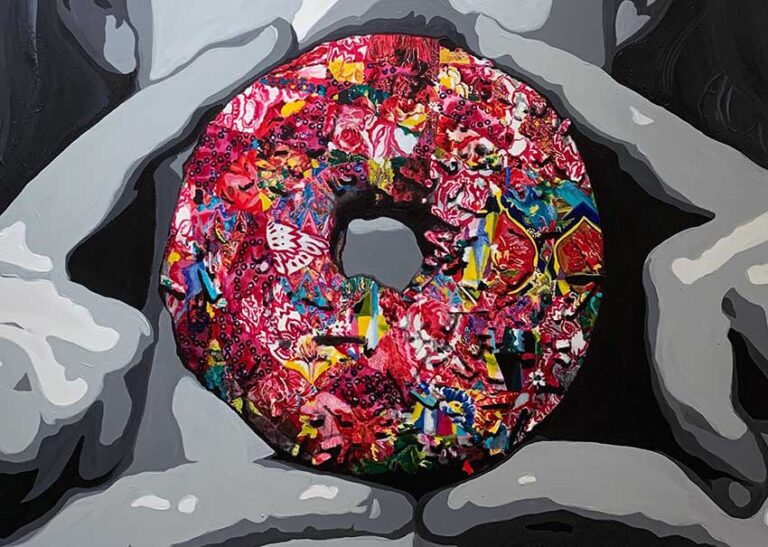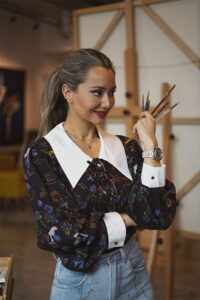In the mesmerizing realm of visual art, where expressive colors and bold patterns grace monochromatic canvases, a profound form of storytelling emerges. I’m Kristel Bechara, a visual artist who weaves tales through artistry, and I invite you to embark on a journey through the captivating narratives within visual creativity. This exploration delves into the profound impact of narratives in artistic expression, touching upon the use of expressive colors and bold patterns on a monochromatic background that depicts life polarities.
Visual art, in its myriad forms, serves as a universal language. Art interpretation transcends the barriers of culture and language, offering a unique medium through which artists convey their stories. Visual art possesses the remarkable ability to communicate complex ideas, evoke emotions, and leave an indelible mark on the viewer’s soul.
Artists across time and cultures have utilized visual art as a means of storytelling. From the intricate cave paintings of Lascaux, dating back over 17,000 years, to contemporary digital art installations, the narrative aspect of visual art has remained a constant thread, binding generations and civilizations.
In the diverse tapestry of humanity, visual art acts as a bridge, connecting people through shared emotions, experiences, and stories. Whether it’s the vibrant canvases of Frida Kahlo, depicting her personal struggles and triumphs, or the thought-provoking installations of Ai Weiwei, challenging societal norms, visual art communicates across boundaries.
At the heart of every exceptional work of visual art lies a story, waiting to be told. It’s a profound expression of the artist’s soul, a reflection of their experiences, beliefs, and emotions. Whether it’s a painting, sculpture, photograph, or any other form, artists utilize their creations as vessels for narratives that touch the human spirit. These narratives can be overt, with a clear storyline, or subtle, leaving room for interpretation and introspection.
Consider, for example, Vincent van Gogh’s iconic “Starry Night.” This masterpiece is not merely a depiction of a serene night sky but an emotional outpouring of the artist’s struggles with mental health and his yearning for tranquility. The swirling stars and the quiet village below become metaphors for the turmoil within his mind.
Narrative art transcends mere aesthetics; it delves deep into the realm of emotional resonance. It seeks to connect with the viewer on a profound level, stirring feelings and thoughts that linger long after one has left the gallery. It’s not limited to the traditional forms of storytelling with a beginning, middle, and end. Instead, it embraces the abstract, the symbolic, and the ambiguous.
Consider Jackson Pollock’s action paintings. At first glance, they may seem like chaotic splatters of paint, devoid of narrative. However, these works invite viewers to engage with the process of creation. They encourage us to question what constitutes art and to find our narratives in the interplay of colors and shapes.
One of the most captivating aspects of storytelling art is its openness to interpretation. Each viewer brings their unique experiences, beliefs, and emotions to the artwork. Thus, the narrative in visual art becomes a deeply personal journey, with each observer finding their story within the art.
Imagine standing before Leonardo da Vinci’s enigmatic “Mona Lisa.” Her enigmatic smile has perplexed art enthusiasts for centuries. Is she smiling or is it a hint of melancholy? The narrative of this painting becomes a dialogue between the viewer and the subject, a conversation that transcends time and space.
Visual narratives are a silent dialogue between the artist and the viewer. They communicate without words, yet they possess the power to convey profound messages. Artists utilize symbols, colors, composition, and even the absence of elements to craft narratives that resonate with diverse audiences.
Consider Grant Wood’s iconic “American Gothic.” The stern expressions of the farmer and his daughter, set against a backdrop of a simple farmhouse, evoke a narrative of resilience, tradition, and the American spirit. This visual narrative speaks to the challenges and hopes of an era and a nation.
Narrative art is a vessel for emotional resonance, leaving an indelible cultural print. It captures the essence of a time, place, or society, evoking nostalgia, provoking critical thought, or reflecting the realities of our world.
Frida Kahlo’s self-portraits, for instance, resonate deeply with themes of pain, identity, and femininity. Her bold and unapologetic portrayal of her physical and emotional struggles has left an enduring emotional impact, inspiring countless artists and feminists worldwide.
For artists like me, storytelling art is a potent form of creative expression. It allows us to explore the intricate interplay of life’s dualities through the canvas. In this dance between the vivid and the restrained, we find the means to express the full spectrum of emotions and perspectives.
My signature style involves using expressive colors and bold patterns on a monochromatic background that depicts life’s polarities. This approach allows me to tell stories through the visual language of art. Whether it’s the contrast between light and dark, chaos and serenity, or joy and sorrow, I seek to capture he essence of the human experience through the interplay of visual elements.
In conclusion, the art of storytelling in visual art is a captivating journey into the human experience. It’s a testament to the power of images and their ability to communicate, connect, and captivate. As we explore the narratives within visual art, we discover not only the stories that artists tell but also the stories that we carry within us, forever intertwined with the art we cherish.
Shop my artwork collection.
Check my digital artwork collection.


